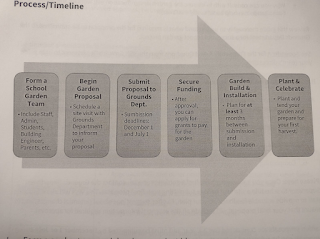Jessie
Hi all, Jessie here on day 5 of our CFE! Greg and I have partnered up to bring you this Friday’s reflections! I wanted to start off with thanking Ms. Rempel and her wonderful students for letting us into their space and to help them with their orchard. Visiting them at Windermere Secondary was a pleasure and was motivating for me because as a developing educator, it gave me extra inspiration to create communities that students feel welcomed and can contribute to equally. In my pedagogy, I talk a lot about building communities within the school and how we can have spaces for them to feel autonomous and welcomed to, but mostly within the classrooms… but why did I not think of the outdoor spaces being a “classroom” space as well!? So far this week, I’ve been beginning to think about what really makes up a “classroom” and how any space can be one.
Windermere’s gardening club is a group of students that take on the role of growing their garden while flourishing as individuals and community building simultaneously. They are mentored by a group of teachers that supervise and pass down their knowledge to all the group members. Much like within the arts, it’s student-centred and I appreciate that their focus is more on the process, rather than the outcomes because we learn best through the actions of doing rather than the final products.
As a teacher, I aspire to foster a space where students can walk into knowing that they are safe, protected by each other, and free to express themselves and their ideas in any shape or form. As a ceramicist myself, I realized that clay is a big part of gardening because it’s a natural material that can benefit gardens whether it be in soil, or to hold the soil. It can create visual aesthetics while also serving a purpose… form and function! This could be a wonderful opportunity for interdisciplinary learning, alongside partnering with the culinary/foods programs too by creating dinnerware to serve the grown food on. I think for myself in the future, if there is a gardening club around, it could be a good opportunity to partner up with some fellow green thumbs around the school and work with them to create or continue a garden space. I have this idea where students in art club could create terracotta planters and pots for the garden since it’s a lot cheaper and should essentially follow the guidelines of the school gardens – as explained by Ms. Rempel. Creating the vessels and pots for the plants to sit in can be a great way to include interdisciplinary learning between several departments (foods, art, biology, wood working, etc.). As someone who also likes to work with flavour and food, it could be interesting to develop a yearly project with the culinary/foods classes to serve school-grown food in student-made dinnerware. Serving on our handmade dinnerware and eating from them is a very special and unique experience.
Talking with a couple of other fellow TCs in our CFE, we’ve also begun to kindle an idea of “garden guardians” as a possible project. Ideally, it would be cool to find a clay deposit close to the garden (or in!) and harvest it to create little creatures and critters inspired by one of our plants. Students would design them and create them with the harvested clay, then left unfired, they would sit above the roots of the plants. Over time, they will begin to decompose back into the ground and find their way back into the soil.
Greg
Today, we had the pleasure of learning about and exploring Ms. Rempel's wonderful orchard and edible garden at Windermere high school. Through her and her dedicated team of students' hardwork, the program has really flourished and the results are amazing. We were led through the day by three of her students who were extremely knowledgeable and gracious enough to give us aspiring teachers an educational walk through the gardens they had put undoubtedly many many hours of work into.
The interdisciplinary skills and knowledge that these students acquire through these programs is astounding. First off, we saw the edible garden in the courtyard with garden beds full of arugula, potatoes, kale and carrots. The food grown here was to be used by the students in the cooking program at the school! We saw the aquaponics equipment from previous years that had once contained fish to be used in a closed loop cogeneration system mimicking a rudimentary ecosystem. How cool! The students had plants set aside for science experiments including one where seeds were sent to space and then their growing behaviour was monitored! Fascinating stuff. Students also utilized ecommerce and sold their abundance of seedlings online to parents and other community members. Finally, it taught the students about being outdoors, growing plants, food security, team work and so much more.
The program comes with its fair share of red tape and obstacles such as a lack of funding, pests, waste management, access to water, time and labour intensiveness etc. However, it was evident with the results and smiles on the students faces that the program was well worth the effort!
Ms. Rempel offered some helpful tips to get started on our own school based community garden. Start small: maybe a small hydroponic herb or tea garden is all you need to begin with. Then you can learn the challenges at a small scale before you bite off more than you can chew. Plan very carefully and consider access to water, access to the roads for supplies and things like extended breaks like summer holidays. Create a proposal to submit to the school board and follow the guidelines that they've set up to ensure your chances of success.
Photos













No comments:
Post a Comment